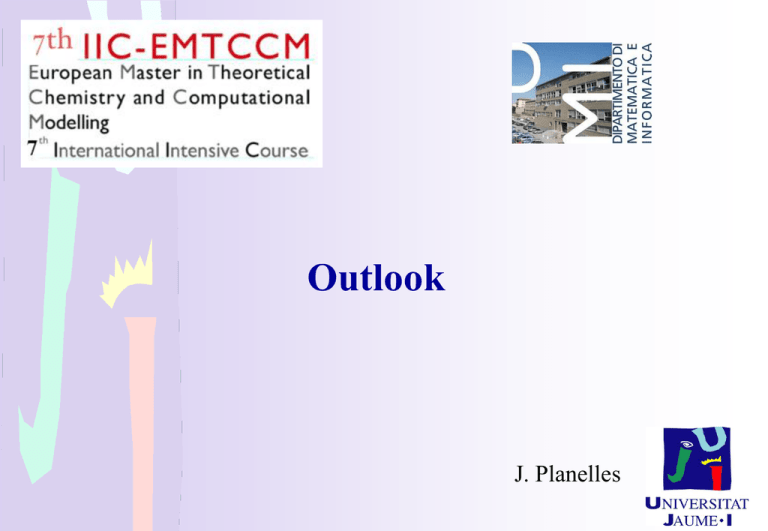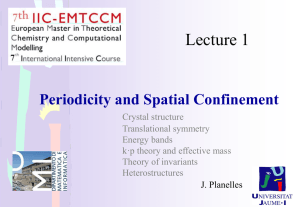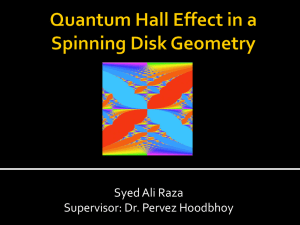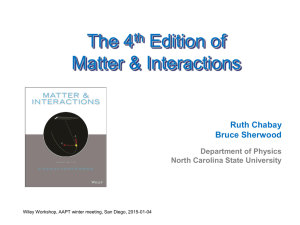Outlook
advertisement

Outlook
J. Planelles
Is this a lattice?
Is this a lattice?
Unit cell: a region of the space that fills the entire crystal by translation
Primitive?
Primitives
Primitive: smallest unit cells (1 point)
Wigner-Seitz unit cell: primitive and captures the point symmetry
Centered in one point. It is the region which is closer to that point than to any other.
Body-centered cubic
Types of crystals
k
k
Conduction Band
Fermi
level
k
few eV
fraction eV
gap
Valence
Band
k
k
Metal
Insulator
• Empty orbitals
available at low-energy:
• Low conductivity
high conductivity
k
Semiconductor
• Switches from conducting
to insulating at will
Positive /negative, lighter/heavier, effective mass
electron
hole
Translational symmetry
a
(x)
( x) ( x na) | f ( x) |2 | f ( x na) |2 f ( x na) ei f ( x)
Tn f ( x) f ( x na )
Tn e
i a n pˆ
(i a n) q q
pˆ
q!
q
Tn Translation Group
[Tn , Tm ] 0 Abelian Group
Bloch functions basis of irreps: k (r ) ei kr u(r ); u(r a) u(r )
i kna i k r
Tn k (r ) ei k( r na)u (r na ) e
e u (r )
character
k
Tn e
i a n pˆ
(i a n) q q
pˆ
q!
q
E
1
Tn
eikna
basis
u (r ) eikr
Solving Schrödinger equation for a crystal: BCs?
For crystals are infinite we use periodic boundary conditions:
Group of translations:
Ta k (r ) ei k a k (r )
k ( - a / 2) ei k (a / 2),
[ , ] ; k 1rst Brillouin zone
(Wigner-Seitz cell of the reciprocal lattice)
We solve the Schrödinger equation for each k value:
The plot En(k) represents an energy band
How does the wave function look like?
ik r
k (r ) e uk (r )
Envelope part
Envelope part
Periodic part
Bloch function
Periodic (unit cell) part
uk (r t ) uk (r )
k·p Theory
2
p
ˆ
H
Vc ( r )
2m
e
i k r
ik r
k (r ) e uk (r )
i
k
r
ˆ
H k (r ) k e
k (r )
2
2 2
p
k
k p
V
(
r
)
u
(
r
)
u
(
r
)
k
k k
2m c
2m
m
n
uk ( r )
n
n
cnk u0 (r )
The k·p
Hamiltonian
Expansion in a basis AND
perturbational correction
One-band Hamiltonian for the conduction band
u0n Hˆ kp u0n'
2
n |k |
k n n'
n,n' u0 p u0
0
2
m
m
2
2
|
k
|
kcb 0cb
2m
2
Crude approximation... including remote bands perturbationally:
2
2
2
|
k
|
kcb 0cb
2 | k |2
2m
m
x, y , z
k
CB
ncb
u0cb
p u0n
2
0cb 0n
1/m*
Free electron
m=1 a.u.
negative mass
k
InAs
m*=0.025 a.u.
1
1 kcb
2
m * k 2
Effective mass
2 2
k
cb
cb
k 0
2m*
Theory of invariants
(Determining the Hamiltonian (up to constants) by symmetry considerations)
3
1. Second order perturbation: H second order in k: H M ij ki k j
i j
2. H must be an invariant under point symmetry (Td ZnBl, D6h wurtzite)
A·B is invariant (A1 symmetry) if A and B are of the same symmetry
e.g. (x, y, z) basis of T2 of Td: x·x+y·y+z·z = r2 basis of A1 of Td
Theory of invariants (machinery)
1. k basis of T2
2. ki kj basis of T2 T2 A1 E T2 [T1 ]
3. Character Table: A1 k x2 k y2 k z2
E 2k z2 k x2 k y2 , k x2 k y2
T2 k x k y , k x k z , k y k z
notation: elements
of these basis: k i .
T1 NO (ki k j symmetric tensor )
irrep
4.Invariant: sum of invariants: H
dim ( )
a Ni ki
i
basis element
fitting parameter
(not determined by symmetry)
Machinery (cont.)
How can we determine the N i matrices?
( J x , J y , J z ) basis of T1, and T2 T2 T1 T1
we can use symmetry-adapted JiJj products
Example: 4-th band model: | 3 / 2,3 / 2 ,| 3 / 2,1/ 2 ,| 3 / 2,1/ 2 ,| 3 / 2,3 / 2
Machinery (cont.)
Form the following invariants
And build the Hamiltonian
Luttinger parameters: determined by fitting
Heterostructures: e.g. QW
How do we study it?
If A and B have:
B
A
z
B
• the same crystal structure
• similar lattice constants
• no interface defects
...we use the “envelope function approach”
i k r
ik r
( z ) uk ( r )
k (r ) e uk (r ) k (r ) e
Project Hkp onto {Ψnk}, considering that:
Envelope part
Periodic part
1
f (r ) unk (r ) dr
unk (r ) dr f (r ) dr
unit cell
Heterostructures
In a one-band model we finally obtain:
B
A
z
B
2 d 2
2 k 2
V ( z)
2m dz2
2m
( z) ( z)
B , k 0
V(z)
A, k 0
1D potential well: particle-in-the-box problem
A
z
2 2
V ( x, y, z ) ( x, y, z ) ( x, y, z )
2m
Most prominent applications:
• Single electron transistor • In-vivo imaging • Photovoltaics
• LEDs
• Cancer therapy
• Memory devices
• Qubits?
Quantum dot
SUMMARY (keywords)
Lattice → Wigner-Seitz unit cell
Periodicity → Translation group → wave-function in Block form
Reciprocal lattice → k-labels within the 1rst Brillouin zone
Schrodinger equation → BCs depending on k; bands E(k); gaps
Gaps → metal, isolators and semiconductors
Machinery: kp Theory → effective mass
J
character table
Theory of invariants: A1; H = Ni ki
Heterostructures: EFA k pˆ i
QWell QWire QDot
confinemen t Vc band offset
Magnetisme
Newton’s Law
Lagrange
equation
Conservative systems
kinematic momentum:
canonical momentum:
Canonical momentum
Newton’s Law
Lagrange
equation
Velocity-dependent potentials: the case of the magnetic field:
kinematic
momentum:
canonical
momentum:
Hamiltonian:
Conservative systems
kinetic + potential energy
Hamiltonian:
Free particle in a magnetic field
Just kinetic energy!
Particle in a potential and a magnetic field:
Gauge
;
Coulomb Gauge :
Always!
Electron in an axial magnetic field
Rosas et al. AJP 68 (2000) 835
Magnetic confining potential
• Landau levels E(B)
• No crossings!
Electron in a spherical QD pierced by a magnetic field
Small QD
Landau
levels
limit
AB crossings
Competition: quadratic vs. linear term
Aharonov-Bohm Effect
E
Φ/ Φ0
• Periodic symmetry changes of the energy levels
•Energetic oscillations
• Persistent currents
Fractional Aharonov-Bohm Effect
1 electron
2 electrons coulomb
interaction
J.I. Climente , J. Planelles and F. Rajadell,J. Phys. Condens. Matter 17 (2005) 1573
The energy spectrum of a single or a many-electron system in a QR (complex topology) can
be affected by a magnetic field despite the field strength is null in the region where the
electrons are confined
It is not the case for a QD (simple connected topology confining potential)
Translations and Magneto-translations
Two-fold periodicity: magnetic and spatial cells
Summary
No magnetic
monopoles:
No conservative field:
Lagrangian:
Canonical
momentum:
Hamiltonian:
Coulomb gauge:
Hamiltonian operator:
vector
potential
velocity-dependent
potential:
kinematic momentum
Magnetic field: summary (cont.)
axial symmetry
Relevant at soft
confinement
(nanoscale and bulk)
Aharonov-Bhom
oscillations in nonsimple topologies
dominates at strong
confinement
(atomic scale)
Spatial
confinement
Magnetic field: summary (cont.)
Periodicity and homogeneous magnetic field
Magneto-translations and Super-lattices
B-dependent (super)-lattice constant
Fractal spectrum (Hofstadter butterfly)








